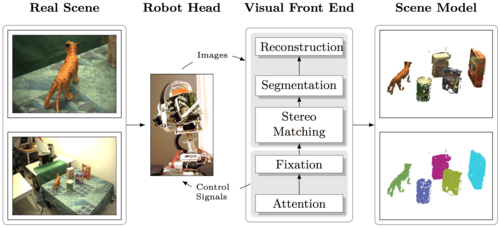Autonomous robots that can assist humans in situations of daily life have been a long standing vision of robotics, artificial intelligence, and cognitive sciences. A first step towards this goal is to create robots that can accomplish a multitude of different tasks, triggered by environmental context or higher level instruction. Early approaches to this goal during the heydays of artificial intelligence research in the late 1980s, however, made it clear that an approach purely based on reasoning and human insights would not be able to model all the perceptuomotor tasks that a robot should fulfill. Instead, new hope was put in the growing wake of machine learning that promised fully adaptive control algorithms which learn both by observation and trial-and-error.
However, to date, learning techniques have yet to fulfill this promise as only few methods manage to scale into the high-dimensional domains of manipulator robotics, or even the new upcoming trend of humanoid robotics, and usually scaling was only achieved in precisely pre-structured domains.
In this thesis, we investigate the ingredients for a general approach to motor skill learning in order to get one step closer towards human-like performance. For doing so, we study two major components for such an approach, i.e., firstly, a theoretically well-founded general approach to representing the required control structures for task representation and execution and, secondly, appropriate learning algorithms which can be applied in this setting.
As a theoretical foundation, we first study a general framework to generate control laws for real robots with a particular focus on skills represented as dynamical systems in differential constraint form. We present a point-wise optimal control framework resulting from a generalization of Gauss' principle and show how various well-known robot control laws can be derived by modifying the metric of the employed cost function. The framework has been successfully applied to task space tracking control for holonomic systems for several different metrics on the anthropomorphic SARCOS Master Arm.
In order to overcome the limiting requirement of accurate robot models, we first employ learning methods to find learning controllers for task space control.
However, when learning to execute a redundant control problem, we face the general problem of the non-convexity of the solution space which can force the robot to steer into physically impossible configurations if supervised learning methods are employed without further consideration. This problem can be resolved using two major insights, i.e., the learning problem can be treated as locally convex and the cost function of the analytical framework can be used to ensure global consistency. Thus, we derive an immediate reinforcement learning algorithm from the expectation-maximization point of view which leads to a reward-weighted regression technique. This method can be used both for operational space control as well as general immediate reward reinforcement learning problems. We demonstrate the feasibility of the resulting framework on the problem of redundant end-effector tracking for both a simulated 3 degrees of freedom robot arm as well as for a simulated anthropomorphic SARCOS Master Arm.
While learning to execute tasks in task space is an essential component to a general framework to motor skill learning, learning the actual task is of even higher importance, particularly as this issue is more frequently beyond the abilities of analytical approaches than execution. We focus on the learning of elemental tasks which can serve as the "building blocks of movement
generation", called motor primitives. Motor primitives are parameterized task representations based on splines or nonlinear differential equations with desired attractor properties. While imitation learning of parameterized motor primitives is a relatively well-understood problem, the self-improvement by interaction of the system with the environment remains a challenging problem, tackled in the fourth chapter of this thesis.
For pursuing this goal, we highlight the difficulties with current
reinforcement learning methods, and outline both established and novel
algorithms for the gradient-based improvement of parameterized
policies. We compare these algorithms in the context of motor
primitive learning, and show that our most modern algorithm, the
Episodic Natural Actor-Critic outperforms previous algorithms by at
least an order of magnitude. We demonstrate the efficiency of this
reinforcement learning method in the application of learning to hit a
baseball with an anthropomorphic robot arm.
In conclusion, in this thesis, we have contributed a general framework for analytically computing robot control laws which can be used for deriving various previous control approaches and serves as foundation as well as inspiration for our learning algorithms. We have introduced two classes of novel reinforcement learning methods, i.e., the Natural Actor-Critic and the Reward-Weighted Regression algorithm. These algorithms have been used in order to replace the analytical components of the theoretical framework by learned representations. Evaluations have been performed on both simulated and real robot arms.


